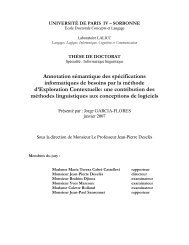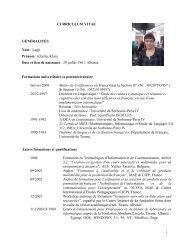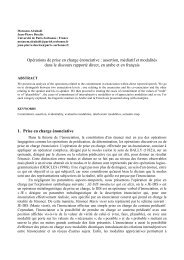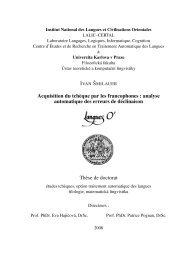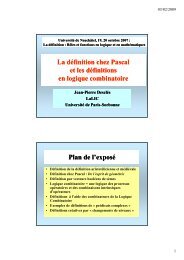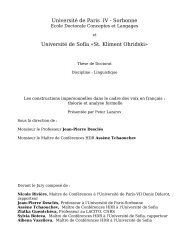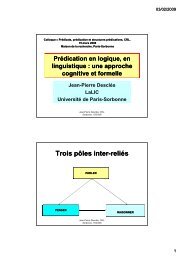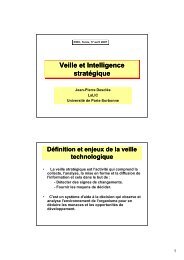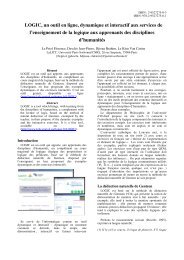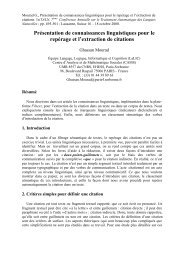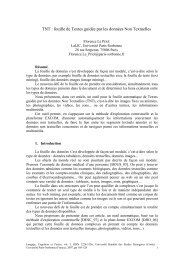- Page 1:
UNIVERSITE PARIS IV { SORBONNE ECOL
- Page 5:
Remerciements Mes remerciements s'a
- Page 8 and 9:
4 Introduction d'autres logiques {
- Page 10 and 11:
6 Introduction 1.2.1 Un apercu hist
- Page 12 and 13:
8 Introduction Pour Meinong l'objet
- Page 14 and 15:
10 Introduction F. Nef considere qu
- Page 16 and 17:
12 Introduction Pour Frege les obje
- Page 18 and 19:
14 Introduction Une approche foncti
- Page 20 and 21:
16 Introduction 2. dire que le quan
- Page 22 and 23:
18 Introduction Dans ce tableau la
- Page 24 and 25:
20 Introduction determination. Cett
- Page 26 and 27:
22 Introduction le niveau cognitif
- Page 28 and 29:
24 Introduction Le chapitre 10 anal
- Page 30 and 31:
26 Introduction probleme n . . Ling
- Page 32 and 33:
28 Introduction la logique avec var
- Page 34 and 35:
30 La categorisation et la quantica
- Page 36 and 37:
32 La categorisation et la quantica
- Page 38 and 39:
34 La categorisation et la quantica
- Page 40 and 41:
36 La categorisation et la quantica
- Page 42 and 43:
38 La categorisation et la quantica
- Page 44 and 45:
40 La categorisation et la quantica
- Page 46 and 47:
42 La categorisation et la quantica
- Page 48 and 49:
44 La categorisation et la quantica
- Page 50 and 51:
46 La categorisation et la quantica
- Page 52 and 53:
48 La categorisation et la quantica
- Page 54 and 55:
50 La categorisation et la quantica
- Page 56 and 57:
52 La categorisation et la quantica
- Page 58 and 59:
54 La categorisation et la quantica
- Page 60 and 61:
56 La categorisation et la quantica
- Page 62 and 63:
58 La categorisation et la quantica
- Page 64 and 65:
60 La categorisation et la quantica
- Page 66 and 67:
62 La categorisation et la quantica
- Page 68 and 69:
64 La categorisation et la quantica
- Page 70 and 71:
66 La categorisation et la quantica
- Page 72 and 73:
68 La categorisation et la quantica
- Page 74 and 75:
70 La categorisation et la quantica
- Page 76 and 77:
72 Critique de la quantication freg
- Page 78 and 79:
74 Critique de la quantication freg
- Page 80 and 81:
76 Critique de la quantication freg
- Page 82 and 83:
78 Critique de la quantication freg
- Page 84 and 85:
80 Critique de la quantication freg
- Page 86 and 87:
82 Critique de la quantication freg
- Page 88 and 89:
84 Critique de la quantication freg
- Page 90 and 91:
86 Critique de la quantication freg
- Page 92 and 93:
88 Critique de la quantication freg
- Page 94 and 95:
90 Critique de la quantication freg
- Page 96 and 97:
92 Critique de la quantication freg
- Page 98 and 99:
94 Critique de la quantication freg
- Page 100 and 101:
96 Critique de la quantication freg
- Page 102 and 103:
98 Critique de la quantication freg
- Page 104 and 105:
100 Critique de la quantication fre
- Page 106 and 107:
102 Critique de la quantication fre
- Page 108 and 109:
104 Critique de la quantication fre
- Page 110 and 111:
106 Critique de la quantication fre
- Page 112 and 113:
108 Critique de la quantication fre
- Page 114 and 115:
110 Critique de la quantication fre
- Page 116 and 117:
112 Critique de la quantication fre
- Page 118 and 119:
114 Critique de la quantication fre
- Page 120 and 121:
116 Critique de la quantication fre
- Page 122 and 123:
118 Critique de la quantication fre
- Page 124 and 125:
120 Critique de la quantication fre
- Page 126 and 127:
122 Critique de la quantication fre
- Page 128 and 129:
124 Critique de la quantication fre
- Page 130 and 131:
126 Critique de la quantication fre
- Page 132 and 133:
128 Critique de la quantication fre
- Page 134 and 135:
130 La quantication en linguistique
- Page 136 and 137:
132 La quantication en linguistique
- Page 138 and 139:
134 La quantication en linguistique
- Page 140 and 141:
136 La quantication en linguistique
- Page 142 and 143:
138 La quantication en linguistique
- Page 144 and 145:
140 La quantication en linguistique
- Page 146 and 147:
142 La quantication en linguistique
- Page 148 and 149:
144 La quantication en linguistique
- Page 150 and 151:
146 La categorisation classiques, q
- Page 152 and 153:
148 La categorisation (au sens que
- Page 154 and 155:
150 La categorisation 6.2 Concepts
- Page 156 and 157:
152 La categorisation memoire colle
- Page 158 and 159:
154 La categorisation le type A de
- Page 160 and 161:
156 La categorisation La sous-clas
- Page 162 and 163:
158 La categorisation Dans la LDO l
- Page 164 and 165:
160 La categorisation ((g f)x) 6=
- Page 166 and 167:
162 La categorisation Pour chaque p
- Page 168 and 169: 164 La categorisation Ness f, Ness
- Page 170 and 171: 166 La categorisation Ness h sg Es
- Page 172 and 173: 168 La categorisation En plus, tous
- Page 174 and 175: 170 La categorisation 6.6 Typique -
- Page 176 and 177: 172 La categorisation { la classe d
- Page 178 and 179: 174 La categorisation { x c occupe
- Page 180 and 181: 176 La categorisation s h:= un quad
- Page 182 and 183: 178 La categorisation L'etendue peu
- Page 184 and 185: 180 La categorisation s s f := un h
- Page 186 and 187: 182 La categorisation { englobe dan
- Page 188 and 189: 184 La categorisation s f:= un tria
- Page 190 and 191: 186 La categorisation s h:= (m,n) p
- Page 192 and 193: 188 La categorisation 6.9 La theori
- Page 194 and 195: 190 La categorisation
- Page 196 and 197: 192 La quantication l'analyse des o
- Page 198 and 199: 194 La quantication Pour la plupart
- Page 200 and 201: 196 La quantication Il s'agit ici d
- Page 202 and 203: 198 La quantication U =(A,f 1 :::f
- Page 204 and 205: 200 La quantication j= :8x (x) ssi
- Page 206 and 207: 202 La quantication . [i-! ] ! [
- Page 208 and 209: 204 La quantication 7.3 Les operate
- Page 210 and 211: 206 La quantication ` EX pour tout
- Page 212 and 213: 208 La quantication Si Ext g 6= ? S
- Page 214 and 215: 210 La quantication (8x) [(francais
- Page 216 and 217: 212 La quantication 2 fg =) red g
- Page 220 and 221: 216 La quantication TYPIQUE(f) (a)
- Page 222 and 223: 218 La quantication g (QL ? f) se l
- Page 224 and 225: 220 La quantication q ; q Tout f ty
- Page 226 and 227: 222 La quantication 2 (^etre carre
- Page 228 and 229: 224 La quantication 20. Un voleur m
- Page 230 and 231: 226 La quantication 7.6.5 Exemples
- Page 232 and 233: 228 La quantication 2 0 : (8 x 2 )[
- Page 234 and 235: 230 La quantication represententles
- Page 236 and 237: 232 La quantication La vraie valeur
- Page 238 and 239: 234 La quantication Tout f est g 2
- Page 240 and 241: 236 La description syntaxique de la
- Page 242 and 243: 238 La description syntaxique de la
- Page 244 and 245: 240 La description syntaxique de la
- Page 246 and 247: 242 Une semantique pour la LDO a: {
- Page 248 and 249: 244 Une semantique pour la LDO Deni
- Page 250 and 251: 246 Une semantique pour la LDO { I
- Page 252 and 253: 248 Une semantique pour la LDO Prop
- Page 254 and 255: 250 Une semantique pour la LDO Rema
- Page 256 and 257: 252 Une semantique pour la LDO l'en
- Page 258 and 259: 254 Une semantique pour la LDO r Et
- Page 260 and 261: 256 Les hierarchies d'heritage et l
- Page 262 and 263: 258 Les hierarchies d'heritage et l
- Page 264 and 265: 260 Les hierarchies d'heritage et l
- Page 266 and 267: 262 Les hierarchies d'heritage et l
- Page 268 and 269:
264 Les hierarchies d'heritage et l
- Page 270 and 271:
266 Les hierarchies d'heritage et l
- Page 272 and 273:
268 Les hierarchies d'heritage et l
- Page 274 and 275:
270 Les hierarchies d'heritage et l
- Page 276 and 277:
272 Les hierarchies d'heritage et l
- Page 278 and 279:
274 Conclusions nature logique" et
- Page 280 and 281:
276 Conclusions { Le systeme formel
- Page 282 and 283:
278 Conclusions Notre opinion est q
- Page 284 and 285:
280 Demonstrations du chapitre 2 Su
- Page 286 and 287:
282 Demonstrations du chapitre 3
- Page 288 and 289:
284 Demonstrations des theoremes du
- Page 290 and 291:
286 Demonstrations des theoremes du
- Page 292 and 293:
288 Demonstrations des theoremes du
- Page 294 and 295:
290 Demonstrations des theoremes du
- Page 296 and 297:
292 Demonstrations des theoremes du
- Page 298 and 299:
294 Demonstrations des theoremes du
- Page 300 and 301:
296 Demonstrations des theoremes du
- Page 302 and 303:
298 Demonstrations des theoremes du
- Page 304 and 305:
300 Demonstrations des theoremes du
- Page 306 and 307:
302 Demonstrations des theoremes du
- Page 308 and 309:
304 Demonstrations des theoremes du
- Page 310 and 311:
306 Bibliographie [Bra86] [Can32] B
- Page 312 and 313:
308 Bibliographie [Des96d] [Des96e]
- Page 314 and 315:
310 Bibliographie [Dum91b] Dummett
- Page 316 and 317:
312 Bibliographie [Hin86] [Hou93] H
- Page 318 and 319:
314 Bibliographie [Par95] Partee B.
- Page 320 and 321:
316 Bibliographie [Sel80] Seldin J.
- Page 322 and 323:
318 Bibliographie
- Page 324 and 325:
320 Table des matieres 3.3 L'algebr
- Page 326 and 327:
322 Table des matieres 10 Les hiera
- Page 328:
324 Liste des gures 9.1 La structur



